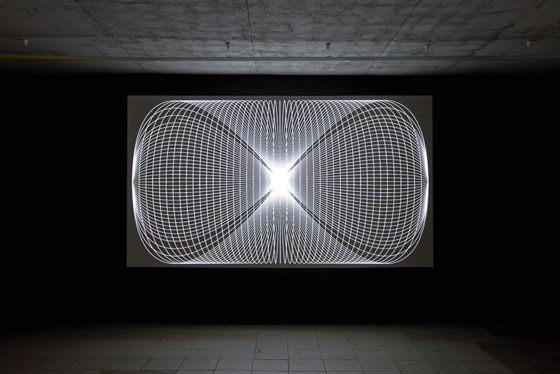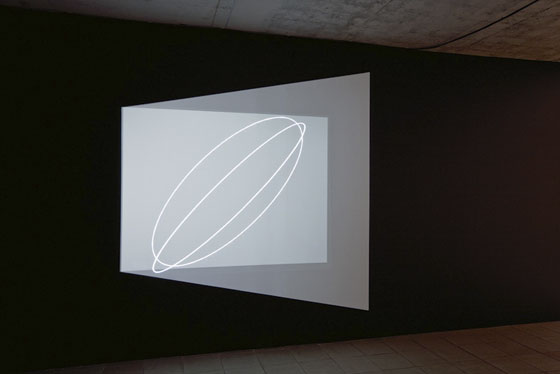|
|
| In waves of excitement Jānis Borgs, Art Critic Mārtiņš Ratniks. Projections 18.02.–27.03.2011. Contemporary Art Centre kim? | |
| As a naive and green music school pupil in the early 1960s, I would come home after class and listen to broadcasts on my family’s Philips radio set. My surfing of Western European music channels was often interrupted by lengthy immersions in the diverse crackling, croaking, squeaking and farting that “normal” people called radio noises and static. I received and enjoyed these amusing oddities as a kind of alternative music. I felt a nervetingling Martian-like acoustic poetry in there. Occasionally my parents or friends caught me in the trancelike state of these “secret sessions”. Their scolding about time wasting was intermingled with secret concerns for my mental health. This was understandable, because these were still deeply conservative Soviet times. However, only a little later, in the 1970s, this bizarre experience helped me to transcend, enthusiastically and effortlessly, cultural barriers and to dive into the world of avant-garde music, in which “squelches and crackling” were considered assets. Gradually I was surrounded by a tiny band of like-minded fans (Boriss Avramecs, Vitauts Drande, Juris Ābols, Jānis Krievs, Ojārs Ābols...). At that time it never entered into my head that one day I would experience the extensive development of this “different” art rooted in science and technology in Latvia’s cultural environment. This slowly evolved from early performances, experiments by kinetic artists and other “designers”, the activities of Hārdijs Lediņš, the global communication events inspired by Indulis Bilzēns... I was even more thrilled when the “weavers” of “net” art emerged at E-LAB in present-day Latvia. Art based in science has today become much more widespread and has gained recognition and acclaim. This was demonstrated, for example, by the nomination of electronic artist Mārtiņš Ratniks for the Vilhelms Purvītis Prize. | |
 Mārtiņš Ratniks. Projections (Projekcijas). Animation. 26 min. 2011 | |
| His latest electronic video artwork Projections is on display in the contemporary art exhibition space kim?. For us, Mārtiņš Ratniks is a brightly shining star with the experience of international artistic “radiation”. And this could be felt here too, tangibly, because the “safe pair of hands” with which the master’s “wave flow” concept was conducted, in an all-round high-quality and technically immaculate manner, is yet another affirmation of this artist’s importance and elevated status. In the darkened exhibition space Ratniks presented three different “oscillographic–dynamic” projections. The central work left a magically evocative impression. Here, with its infinite figure-of-eight track the electronic line created fine lace embroidery. Its mechanically precise progression gradually transformed the entire screen field from black darkness to bright whiteness. But then the cycle of movement reversed itself. In the course of observation, this amazing aesthetic adventure turns into a philosophical reflection, as if to prove once again the Buddhist-like revelation that the only absolute in the universe is constant change. And at the same time it affirms that the work only appears to be decorative, ornamental, because mathematical art like this offers a glimpse into the depths of being. In other projections, by constantly moving across the plane of the screen, Ratniks’ electronic drawings create geometric illusionary spatial situations. In his commentary, the author remarks truthfully that these are only phantasms created in the consciousness, “errors” of brain activity. In reality, there is only a plane, because the eye only perceives flat projections. The evaluation and analysis of what we see takes place in the brain, which gives us a “message” about the existence of space. In this case the mistake is rectified by accumulated knowledge which significantly adjusts our interpretation of what we see. | |
 Mārtiņš Ratniks. Projections (Projekcijas). Animation. 26 min. 2011 | |
| Ratniks’ insights into the peculiarities of seeing do require a little supplementation or even a correction. We see the world as we know it. We only see that which we know. Because a fly, a cat and a human being all see the same reality, but each creature’s consciousness interprets it completely differently, and the capacity of each consciousness is limited. Reality is unlimited, but biological consciousness is always limited. It can therefore be concluded that everything that we see is to an extent only a mirage, whose interpretation depends entirely on our level of and capacity for awareness. And any projection of reality in the eye is only partially complete (limited by the capability of the beholder, i.e., the eye), and our understanding of this is limited by our brain capacity and accumulated knowledge. Beyond that is infinity, the perception of which we can, perhaps, constantly expand, but never reach in its totality. This can all be expressed in one simple formula: “what you see is never what you see.” Or as the Russian poet Alexander Tvardovsky wrote – За далью – даль (“beyond the distance – distance”)... In the context of Mārtiņš Ratniks’ exhibition, the author’s reminiscences at the beginning of this article were summoned up by Lauris Vorslavs and Ģirts Radziņš from the musicians’ association Clausthome, who provided the acoustic accompaniment for the exposition. The activities of these sound artists cover “... the scanning of various types of radio frequencies, collection of radio signals, sound feedback and modulation experiments.” Submitting to the undulations of all these artistic waves, I inadvertently felt like Henry Morton Stanley heading off to Africa in search of the lost British explorer Dr David Livingstone. On 10 November 1870, he came to the town of Uzizi on Lake Tanganyika where he saw a white man amidst a group of natives. Their meeting was introduced by Stanley’s legendary phrase: “Dr Livingstone, I presume?” That, perhaps, is exactly what I wanted to say when looking at Martiņš Ratniks’ projections. The loop is closed. New circles are forming... /Translator into English: Filips Birzulis/ | |
| go back | |







